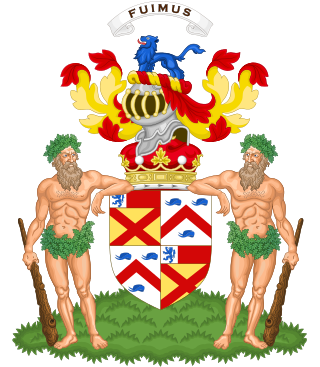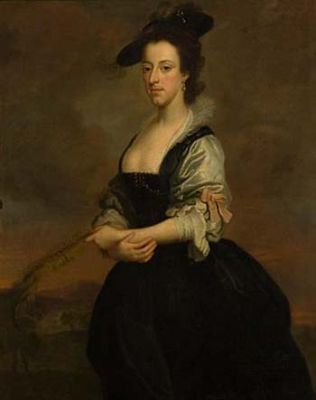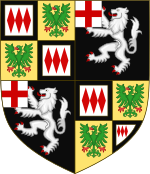
Duke of Bedford is a title that has been created six times in the Peerage of England. The first and second creations came in 1414 and 1433 respectively, both in favour of Henry IV's third son, John, who later served as regent of France. He was made Earl of Kendal at the same time and was made Earl of Richmond later the same year. The titles became extinct on his death in 1435. The third creation came in 1470 in favour of George Neville, nephew of Warwick the Kingmaker. He was deprived of the title by Act of Parliament in 1478. The fourth creation came in 1478 in favour of George, the third son of Edward IV. He died the following year at the age of two. The fifth creation came in 1485 in favour of Jasper Tudor, half-brother of Henry VI and uncle of Henry VII. He had already been created Earl of Pembroke in 1452. However, as he was a Lancastrian, his title was forfeited between 1461 and 1485 during the predominance of the House of York. He regained the earldom in 1485 when his nephew Henry VII came to the throne and was elevated to the dukedom the same year. He had no legitimate children and the titles became extinct on his death in 1495.

Duke of Buccleuch, formerly also spelt Duke of Buccleugh, is a title in the Peerage of Scotland created twice on 20 April 1663, first for James Scott, 1st Duke of Monmouth, and second suo jure for his wife Anne Scott, 4th Countess of Buccleuch. Monmouth, the eldest illegitimate son of King Charles II, was attainted after rebelling against his uncle King James II and VII, but his wife's title was unaffected and passed on to their descendants, who have successively borne the surnames Scott, Montagu-Scott, Montagu Douglas Scott and Scott again. In 1810, the 3rd Duke of Buccleuch inherited the Dukedom of Queensberry, also in the Peerage of Scotland, thus separating that title from the Marquessate of Queensberry.

Duke of Manchester is a title in the Peerage of Great Britain, and the current senior title of the House of Montagu. It was created in 1719 for the politician Charles Montagu, 4th Earl of Manchester. Manchester Parish in Jamaica was named after the 5th Duke, while its capital Mandeville was named after his son and heir. The current Duke is Alexander Montagu, 13th Duke of Manchester, a controversial British and Australian citizen who lives in the United States and has served several prison sentences. He succeeded to the peerage in 2002 following the death of his father Angus Montagu, 12th Duke of Manchester, the last of the dukes to hold a seat in the House of Lords.

Marquess of Ailesbury, in the County of Buckingham, is a title in the Peerage of the United Kingdom. It was created on 17 July 1821 for Charles Brudenell-Bruce, 2nd Earl of Ailesbury.

Earl of Cardigan is a title in the Peerage of England, currently held by the Marquesses of Ailesbury, and used as a courtesy title by the heir apparent to that Marquessate, currently David Brudenell-Bruce, Earl of Cardigan, son of the 8th Marquess. The Brudenell family descends from Sir Robert Brudenell, Chief Justice of the Common Pleas from 1520 to 1530. His great-grandson, Sir Thomas Brudenell, was created a Baronet in the Baronetage of England, styled "of Deene in the County of Northampton", on 29 June 1611. On 26 February 1628, he was raised to the Peerage of England as Baron Brudenell, of Stanton Wyvill in the County of Leicester, and on 20 April 1661 he was further honoured when he was made Earl of Cardigan, also in the Peerage of England. On his death, the titles passed to his son, Robert, the 2nd Earl, and on the 2nd Earl's death to his grandson, George, the 3rd Earl, the 2nd Earl's only son, Francis, Lord Brudenell, having predeceased his father.

Duke of Kingston-upon-Hull was a title in the Peerage of Great Britain, with the title Earl of Kingston-upon-Hull being a title in the Peerage of England. The Earldom was created on 25 July 1628 for Robert Pierrepont, 1st Viscount Newark. The Dukedom was created on 10 August 1715 for his great-grandson, Evelyn Pierrepont, 1st Marquess of Dorchester, who had succeeded as the fifth Earl of Kingston-upon-Hull in 1690. The Dukedom became extinct on the death of the second Duke in 1773. Unlike the city to which they refer, Kingston upon Hull, which is usually shortened to Hull, these titles are usually shortened to Duke of Kingston.. They should not be confused with the separate Irish Earldom of Kingston.

Baron Montagu of Boughton is a British title which has been created twice for members of the Noble House of Montagu. First created in 1621, in the Peerage of England, for Sir Edward Montagu, eldest son of Sir Edward Montagu of Boughton and grandson of another Sir Edward Montagu who had been Lord Chief Justice during the reign of Henry VIII. He was also the brother of Henry Montagu, later created Earl of Manchester, and of Sidney Montagu, ancestor of the Earls of Sandwich.

Ralph Montagu, 1st Duke of Montagu was an English courtier and diplomat.

John Montagu, 2nd Duke of Montagu,, styled Viscount Monthermer until 1705 and Marquess of Monthermer between 1705 and 1709, was a British peer.

Henry Scott, 3rd Duke of Buccleuch and 5th Duke of Queensberry KG FRSE was a Scottish nobleman and long-time friend of Sir Walter Scott. He is the paternal 3rd great-grandfather of Princess Alice, Duchess of Gloucester, and the maternal 4th great-grandfather of Prince William of Gloucester and Prince Richard, Duke of Gloucester.

Sir Edward Montagu of Boughton, Hanging Houghton and Hemington in Northamptonshire was an English lawyer and judge in the time of Henry VIII and Edward VI. He was Chief Justice of the King's Bench from 1539 to 1545 and Chief Justice of the Common Pleas from 1545 to 1553.

George Montagu, Duke of Montagu KG, PC, FRS styled Lord Brudenell until 1732 and known as the Earl of Cardigan between 1732 and 1766, was a British peer.

The titles Baron Montacute or Baron Montagu were created several times in the Peerage of England for members of the House of Montagu. The family name was Latinised to de Monte Acuto, meaning "from the sharp mountain"; the French form is an ancient spelling of mont aigu, with identical meaning.

John Montagu, Marquess of Monthermer, 1st Baron Montagu of Boughton was a British peer.

The House of Montagu, also known throughout history as Montagud, Montaigu, Montague, Montacute, is an English noble family founded in Somerset after the Norman Conquest of 1066 by the Norman warrior Drogo de Montagud. They rose to their highest power and prominence in the 14th and 15th centuries as Earls of Salisbury, the last in the male line being Thomas Montagu, 4th Earl of Salisbury (1388–1428), the maternal grandfather of "Warwick the Kingmaker", 16th Earl of Warwick and 6th Earl of Salisbury.
Montagu is an English surname of Old French origin, a form of Montague. One notable family with this surname is the House of Montagu, who include the Earls of Sandwich. Notable people with the surname include:

Mary Montagu, Duchess of Montagu, known as Countess of Cardigan between 1730 and 1749, was the wife of George Brudenell, 4th Earl of Cardigan. She was the daughter of John Montagu, 2nd Duke of Montagu, on whose death in 1749 her husband inherited the family estates and took the surname "Montagu". Her mother was Lady Mary Churchill, daughter of John Churchill, 1st Duke of Marlborough. In 1766, her husband the earl was made a duke, reviving the titles that had become extinct as a result of his father-in-law's death without a male heir.

Elizabeth Scott, Duchess of Buccleuch, formerly Lady Elizabeth Montagu, was the wife of Henry Scott, 3rd Duke of Buccleuch.

Elizabeth Brudenell, Countess of Cardigan, formerly Lady Elizabeth Bruce, was an English noblewoman and a petitioner for the foundation of the Foundling Hospital in London. Her husband was George Brudenell, 3rd Earl of Cardigan, and she was the mother of the 4th Earl, who later became 1st Duke of Montagu.
Henry James Montagu-Scott, 2nd Baron Montagu of Boughton















